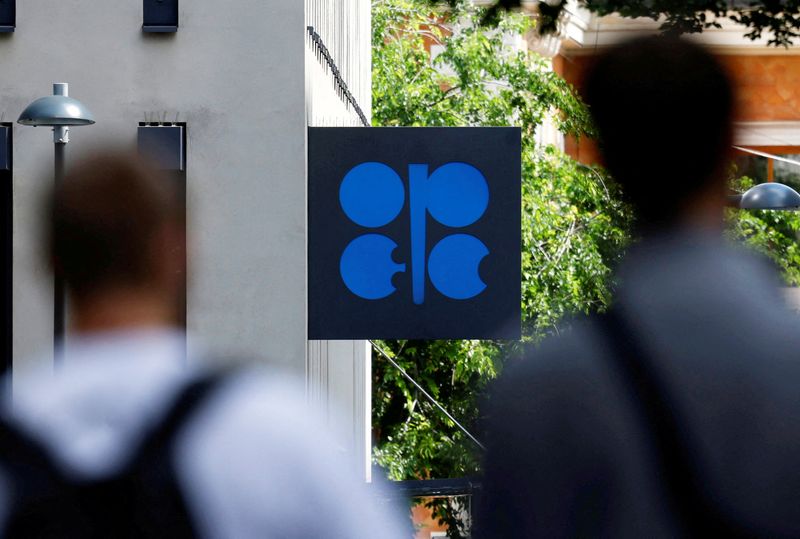Analysis-OPEC+ may stick with deep oil cuts for longer due to weak demand
By Alex Lawler, Ahmad Ghaddar and Robert Harvey
LONDON (Reuters) - OPEC+ will have little room to manoeuvre on oil policy when it meets in December: it would be risky to increase output because of weak demand, and difficult to deepen supply cuts because some members want to pump more, sources and analysts said.
The Organization of the Petroleum Exporting Countries and its allies led by Russia, the group known as OPEC+, which pumps around half the world's oil, has already delayed a plan to gradually lift production by several months this year.
It may push back output increases again when it meets on Dec. 1 due to weak global oil demand, according to three OPEC+ sources familiar with the discussions. Ministers last shelved the increase for a month when they met virtually on Nov. 3.
"I can't say it's popular in the group but there would be no strong objection to a delay until the first quarter," one of the OPEC+ sources said, declining to be identified by name.
Two other OPEC+ sources said it was too early to say what the group will decide. OPEC and the Saudi government communications office did not immediately respond to a request for comment.
OPEC+ had planned to slowly roll back production cuts with small increases over many months in 2024 and 2025. But a slowdown in Chinese and global demand, and rising output outside the group, have put a dampener on that plan.
This has left OPEC+ maintaining output cuts for longer than it had thought. The group has cut output by 5.86 million barrels per day, or about 5.7% of global demand, in a series of steps agreed since 2022 to support the market.
Despite OPEC+'s cuts and delays to output hikes, oil prices have mostly stayed in the $70-$80 per barrel range this year.
Saudi Arabia was keen to address an internal issue of poor compliance with production targets from some OPEC+ members, sources said, before proceeding with any output increase for the group.
Some members including Iraq have reduced output in recent months, so compliance has improved. That could give the group a little room for a coordinated small increase in supply - as long as demand supports it.
Increasing output in a market with little demand growth, however, would risk weakening prices. It is a tactic OPEC+ could use to put pressure on rivals - but one that would also hurt OPEC+ countries that rely on oil revenues.
Many OPEC members need a price of over $70 to balance their budgets and could not sustain a long period of oil below $50.
LOW CHANCE OF 'PRICE WAR'
Nonetheless, OPEC+'s falling market share has led to speculation that sooner or later, it may launch a price war to push rivals out. The last time OPEC did this was in 2014-2015, when it raised output to squeeze U.S. shale firms.
OPEC+'s oil output is equal to 48% of world supply, the lowest since it was formed in 2016 with a market share of over 55%, according to Reuters calculations based on International Energy Agency figures.
The U.S. has become the world's largest oil producer, pumping more than 20 million bpd or a fifth of global production. Top OPEC producer Saudi Arabia's crude output is less than 9% of the global oil total, while OPEC supplies around 25%.
The 2014 price war had a big impact on shale producers but ultimately failed to stem the boom. U.S. shale and other producers have also cut costs over time, making it harder for OPEC+ to win a new battle.
The cost of producing oil onshore in the Middle East has an average breakeven price of $27 a barrel, according to consultant Rystad Energy. Rystad puts North American costs at $45, down from $85 in 2014.
"Crude needs to price below $40-$45 to significantly curtail non-OPEC supply," said Aldo Spanjer of BNP Paribas (OTC:BNPQY ), who puts the chance of a price war at just 20%.
Consolidation in the U.S. oil industry would also make it harder for OPEC+ to win a price war. In the past two years U.S. majors Exxon Mobil (NYSE:XOM ) and Chevron (NYSE:CVX ) have bought some of the biggest shale producers. They have deep pockets and diverse portfolios.
"We think speculation about a possible supply war is overblown," said Richard Bronze of Energy Aspects. "Unlike in 2015-2016, the group recognises that U.S. and wider non-OPEC production is not going to decline rapidly."
DEEPER CUTS ALSO UNLIKELY
Analysts at Macquarie said the prospects for OPEC+ increasing output in the first half of 2025 looked tenuous given seasonal demand weakness.
Deepening production cuts is also unlikely because several OPEC+ members are pushing to pump more, not less.
Key among them is the United Arab Emirates, which argues it has kept output at around 3 million bpd for too long, far below its capacity.
The UAE has already secured an increased quota for 2025, and any delay to output hikes would need to address this issue, OPEC+ sources said. Iraq has also been pushing for a higher quota.
"We think deeper cuts, which ultimately may be required to support oil prices next year, could be difficult to stomach," said Walt Chancellor of Macquarie.
Source: Investing.com
